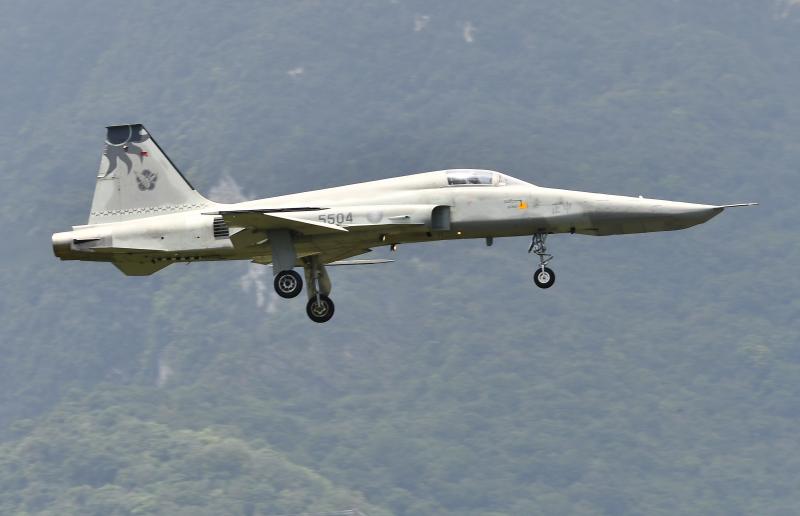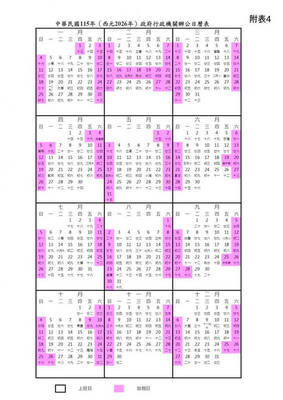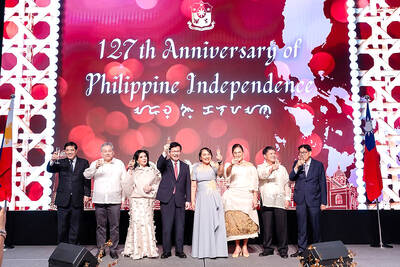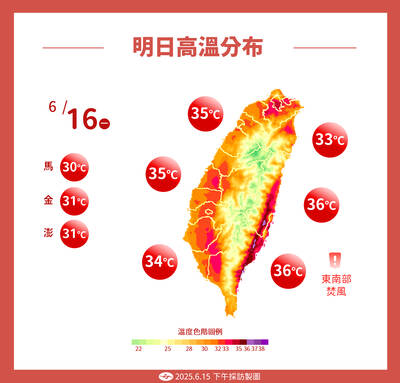The air force would continue to allocate about NT$10 million (US$314,085) next year to keep its RF-5 recon aircraft fleet operational until it receives new intelligence, surveillance and reconnaissance (ISR) capabilities, a military source told the Central News Agency today.
According to the air force's budget proposal for the fiscal year 2025, NT$10 million would be spent on logistics and technical support services to keep the RF-5s up and running.

Photo: Yu Tai-lang, Taipei Times
The proposal is still pending approval by lawmakers.
The RF-5s were converted from some of the air force's F-5E jets that have been in service for nearly 50 years.
Based in Hualien Air Base, the plane's main mission is to conduct recon missions with F-16Vs and surveil Chinese forces.
During natural disasters such as earthquakes and floods, the RF-5s also conduct recon missions to help gather information on the scale of the destruction.
The air force had about 50 F-5s that have mostly served as trainer jets.
All of them were retired from service late last year and replaced by Taiwan's indigenous advanced jet trainers, also known as the Brave Eagle.
However, the RF-5 reconnaissance version is to remain operational until the military receives new ISR capabilities with the future inclusion of MS-110 pods, MQ-9B drones and domestic drones in coming years, an unnamed source told the news agency.
Washington approved the sale of six MS-110s in October 2020, but the military has yet to receive them.
The delivery is expected to be completed next year.
Taiwan's military is also scheduled to receive the first two MQ-9B "SkyGuardian" drones it purchased from the US in 2026, and the other two in 2027.

Taiwan is to have nine extended holidays next year, led by a nine-day Lunar New Year break, the Cabinet announced yesterday. The nine-day Lunar New Year holiday next year matches the length of this year’s holiday, which featured six extended holidays. The increase in extended holidays is due to the Act on the Implementation of Commemorative and Festival Holidays (紀念日及節日實施條例), which was passed early last month with support from the opposition Chinese Nationalist Party (KMT) and Taiwan People’s Party. Under the new act, the day before Lunar New Year’s Eve is also a national holiday, and Labor Day would no longer be limited

COMMITMENTS: The company had a relatively low renewable ratio at 56 percent and did not have any goal to achieve 100 percent renewable energy, the report said Pegatron Corp ranked the lowest among five major final assembly suppliers in progressing toward Apple Inc’s commitment to be 100 percent carbon neutral by 2030, a Greenpeace East Asia report said yesterday. While Apple has set the goal of using 100 percent renewable energy across its entire business, supply chain and product lifecycle by 2030, carbon emissions from electronics manufacturing are rising globally due to increased energy consumption, it said. Given that carbon emissions from its supply chain accounted for more than half of its total emissions last year, Greenpeace East Asia evaluated the green transition performance of Apple’s five largest final

Taiwan is to extend its visa-waiver program for Philippine passport holders for another year, starting on Aug. 1, Minister of Foreign Affairs Lin Chia-lung (林佳龍) said on Friday. Lin made the announcement during a reception in Taipei marking the 127th anniversary of Philippine independence and the 50th anniversary of the establishment of the Manila Economic and Cultural Office (MECO) in Taiwan, the Ministry of Foreign Affairs said. The decision reflected Taiwan’s commitment to deepening exchanges with the Philippines, the statement cited Lin as saying, adding that it was a key partner under the New Southbound Policy launched in 2016. Lin also expressed hope

Temperatures in New Taipei City’s Sindian District (新店) climbed past 37°C yesterday, as the Central Weather Administration (CWA) issued heat alerts for 16 municipalities, warning the public of intense heat expected across Taiwan. The hottest location in Taiwan was in Sindian, where the mercury reached 37.5°C at about 2pm, according to CWA data. Taipei’s Shilin District (士林) recorded a temperature of 37.4°C at noon, Taitung County’s Jinfeng Township (金峰) at 12:50 pm logged a temperature of 37.4°C and Miaoli County’s Toufen Township (頭份) reached 36.7°C at 11:40am, the CWA said. The weather agency yesterday issued a yellow level information notice for Taipei, New